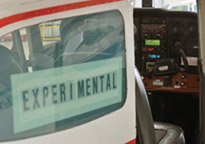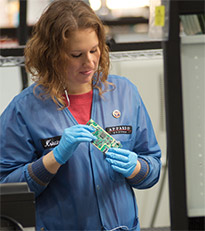Appareo transponder in flight testing
Since early October, a white, blue, and red Cessna 172 has been making regular flights from Hector International Airport in Fargo, North Dakota. The bold Experimental lettering tells you it’s not a routine personal or training flight, however.
Appareo Systems is using the leased Cessna 172 for certification flight testing of its new Stratus ESG 1090-MHz Extended Squitter transponder. The extended squitter function transmits Automatic Dependent Surveillance-Broadcast Out data, mandated by the FAA beginning January 1, 2020, for most operations in airspace where a transponder is required today.
“Our flight tests have been going as close to perfect as we could have hoped for,” said Vern Miller, Appareo’s certification specialist. “We’re currently on schedule. The FAA has been very supportive in working with us on all aspects of this project.”
Appareo announced the ESG in April during the Aircraft Electronics Association convention in Dallas. While there are several 1090ES transponders on the market that can help aircraft owners meet the ADS-B Out mandate, Appareo’s ESG could become only the second certified 1090ES transponder to offer an integrated Wide Area Augmentation System-compatible GPS receiver (ADS-B Out requires a WAAS GPS position source). And at $3,490, it would be the first at its price point. (L-3 Avionics Systems’ 1090ES transponder, the NGT-9000, also incorporates a WAAS GPS—as well as ADS-B In, an interface to cockpit displays, and its own integral display, none of which the ESG offers. NGT-9000 pricing begins at $6,800.)
Appareo is best known among pilots and aircraft owners for its popular Stratus line of portable ADS-B In receivers, but they don’t represent the firm’s first foray into aviation.
In 2006 the Bristow Group, which operates a large helicopter fleet, asked Appareo to develop a lightweight, low-cost flight data monitoring system. This resulted in the Aircraft Logging and Event Recording for Training and Safety (ALERTS) FDM program, and the GAU 2000 data recording device, which received FAA certification. The system allowed Bristow to identify trends that likely would have resulted in incidents or accidents.
Since then, Appareo developed and certified another, smaller recording device—the Vision 1000—which has replaced the GAU 2000. The ALERTS program provides automated events analysis, helping to assure compliance with standard operating procedures, and offers the ability to replay flights for training, maintenance troubleshooting, and incident investigation. It’s used on many Airbus helicopters and a number of Piper piston-engine aircraft, among other aircraft.
Work started on the company’s first ADS-B project, a UAS Sense and Avoid test avionic under an Office of Naval Research contract, in 2009 with the product delivered in 2010. It was used for unmanned aircraft system cooperative airspace demonstrations. “It showed that we could build things small, light, and compact,” said Jeff Johnson, Appareo’s vice president for business development.
In 2011, Tyson Weihs—co-founder and CEO of ForeFlight—asked the company about building an ADS-B receiver. That led to a partnership between ForeFlight, Sporty’s Pilot Shop, and Appareo for the Stratus 1 portable receiver. “It leveraged our ADS-B knowledge into a commercial product,” Johnson said. “We were just shocked at how receptive the market was to it.” Introduced in May 2012, the product line has evolved and now consists of the Stratus 1S ($549) and Stratus 2S ($899).
The company decided to focus next on a cost-effective ADS-B Out product for the non-glass-panel market. A transponder eliminates the need to synchronize squawk codes, as well as a separate control head, and Appareo believes installation costs will be less than for a universal access transceiver (UAT) operating on 978 MHz. “We decided the easiest, lowest-cost thing we could do was create that panel-mount avionic,” Johnson said.
To keep costs down, the company developed and is working toward technical standard order approval for its own WAAS GPS receiver. Instead of incorporating the optional ADS-B In, Appareo customers who want ADS-B weather and traffic information can continue using their Stratus receivers. The Stratus 2 and anything newer can receive ADS-B and GPS signals, as well as power, from the ESG; users get more flexibility because the Stratus no longer needs to sit on the glareshield.
Mike Paulson, manager of Fargo Jet Center’s flight school, is piloting the certification test flights. One or two Appareo engineers join him for each flight. A Bendix/King KT 76A transponder was removed from the leased 1977 Cessna 172N to make room for the ESG. The Skyhawk is equipped with a standard six-pack of analog flight instruments and the panel appears to otherwise be substantially as delivered. Because an operating transponder still is required after the ADS-B Out mandate kicks in, Appareo considers its solid-state transponder an important part of the product’s value.
Miller, the certification specialist, has planned eight different flight profiles. “We’re looking at specific maneuvers to ensure that we can show continuity with the [ADS-B] ground stations,” he said. “We’re looking to repeat them about five times,” in different locations. After each flight, engineers will correlate radar data from flight following, as well as ADS-B data on the flight from the FAA in Washington, D.C., and observations from the aircraft’s occupants.
The 40 planned flights should accrue 35 to 40 flight hours, Miller said. “That’s subject to change if we learn a lot, or other issues come up. After a flight, we’ll put three or four engineers on the data and analyze it before the next flight.” Changes can be made between flights if necessary, he added.
Like the Stratus receivers, the Stratus ESG transponder will be manufactured at Appareo’s Fargo headquarters. The company moved into a new building—located between North Dakota State University and the airport—in March 2015. Manufacturing became operational in the new facility in May. It contains two SMT lines (surface mount technology, where electronic components are positioned on circuit boards and soldered in place) and has room for two more before the building, designed for expansion, would have to be enlarged. Three-fourths of the new building is comprised of manufacturing space; engineering offices are located next door in the company’s previous building.
ESG manufacturing preparations have begun. “We have to be able to vet out the manufacturing process, to make sure what we designed is what we produce,” Miller explained. “Pretty much everything’s sourced.”
Appareo was an early participant in North Dakota’s Centers for Excellence program, started in 2003 to leverage research in the state, said Tony Grindberg, manager of the company’s aviation business unit. The company partnered with North Dakota State University’s engineering program in Fargo, and University of North Dakota Aerospace in Grand Forks, for seed funding. Appareo also will provide free ADS-B Out and In avionics to 70 North Dakota aircraft owners.
The company has said it wants to complete its ESG certification submission this year and receive FAA certification and begin deliveries in 2016.
What’s next for the company? “ESG for us is a starting point,” and a flagship product, said David Batcheller, president and chief operating officer. “We’re going to exploit our understanding of the certification process and the business’s ability to certify new products.” He said he would like to jump into Part 25 and large turbine aircraft.
“We’re also in the agricultural industry,” Johnson noted, “and there’s an intersection” between agriculture and aviation—unmanned aircraft systems.
Email [email protected]

Circuit boards for Stratus ADS-B receivers are ready for finalassembly at Appareo’s Fargo, North Dakota, factory (top of page). Appareo’s ESG transponder is installed in a Cessna 172 for certification flight testing (above).

Kristin Pennie, an Appareo manufacturing assembler, inspects a Stratus circuit board.
Photography on top of page: John Pedersen




